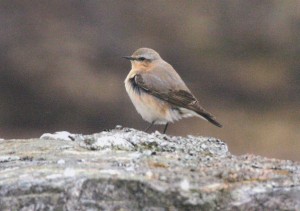 To many people the first summer bird migrants of the year to look out for in the Highlands are the ospreys or the swallows but there is another bird that is also early but often overlooked. This is the wheatear that is not much larger than a robin. Its most conspicuous identification feature is when it flies as the large areas of white feathers on the rump and upper tail contrasts with the black T shape of feathers on the tail. The male has black cheeks with a white stripe over the eye and across the forehead. The wings are black and when folded contrast with the blue grey feathers of the back. The female, as shown in the photograph, is duller and sandy brown with a less marked face and browner wings. The photograph was taken in a stony field in Strathdearn on the side of the River Findhorn in early March this year.
To many people the first summer bird migrants of the year to look out for in the Highlands are the ospreys or the swallows but there is another bird that is also early but often overlooked. This is the wheatear that is not much larger than a robin. Its most conspicuous identification feature is when it flies as the large areas of white feathers on the rump and upper tail contrasts with the black T shape of feathers on the tail. The male has black cheeks with a white stripe over the eye and across the forehead. The wings are black and when folded contrast with the blue grey feathers of the back. The female, as shown in the photograph, is duller and sandy brown with a less marked face and browner wings. The photograph was taken in a stony field in Strathdearn on the side of the River Findhorn in early March this year.
Wheatears are often overlooked as they haunt rocky and stony places associated with unimproved grassland or moorland. They rarely fly and feed on the ground where they are restless and always seem to be on the move in short runs and they have the habit of sitting, upright, on rocks and posts. Their food is mainly taken on the ground and generally consists of various insects including moths, beetles and flies but they will also take small snails and worms. They will also take, surprisingly, the berries of blackberry, rowan and elder. One unusual feature of the wheatear is that it nests either in holes and crevice in walls or stony areas or sometimes underground and old rabbit burrows are often used.
Some of the early wheatears to arrive in Spring in the Highlands are, incredibly, only part of their way from their wintering grounds in Africa. These are the slightly larger, bolder coloured birds that are known as Greenland wheatears. They are a race of the wheatears we see in the Highlands and they breed, as the name suggests, in Greenland. As for the Scottish birds there are estimated to be around 60,000 pairs that breed. They are found in most parts of the Highlands and Islands including the Western Isles and the Northern Isles and can be found on even the remotest of islands such as North Rona and St. Kilda. The number of breeding pairs appear stable but there is the worry that they had gone from some areas that have been taken for afforestation and agricultural changes. As with many other birds one constant threat is the hunting along its migration routes. Some countries still eat them despite their small size and there they are considered a delicacy. Even in Britain they were at one time trapped in considerable numbers for eating. Charles St. John who wandered the Highlands in the 1800s wrote “I used to be adept at catching them in horsehair nooses as we used to consider them particularly good eating”.
In the Highlands the wheatear has long been associated with myths and folk lore. They were considered to be unlucky because of their supposed connections with the Devil and, for some unknown reason, toads. Even to hear the bird was a sign of bad luck especially if it was perched on a stone, the bird’s common habit. Not surprising then it has around twenty Scots names and three Gaelic names, the commonest being Clacharan which is shared with the stonechat meaning trembling one. At one time, before migration was understood, it was thought that the birds simply stayed underground for the winter months just as the swallow was believed to have hibernated under water.
